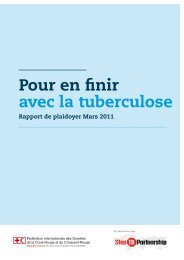Thailand - Stop TB Partnership
Thailand - Stop TB Partnership
Thailand - Stop TB Partnership
You also want an ePaper? Increase the reach of your titles
YUMPU automatically turns print PDFs into web optimized ePapers that Google loves.
MDR-<strong>TB</strong><br />
National figures obscure local differences. . . . There are subepidemics by<br />
regions and populations. Many groups are not included in the national<br />
figures. For migrant workers, we don’t do cultures. We just treat them.<br />
—Comment at Public Health Watch roundtable meeting 79<br />
Most <strong>TB</strong> experts believe that MDR-<strong>TB</strong> is not a severe problem since the estimated national<br />
prevalence is only 0.9 percent. 80 However, there is considerable concern that significantly<br />
higher rates of drug resistance among vulnerable groups such as prisoners and migrants<br />
could quickly lead to higher rates among the general population as well.<br />
Though the national MDR-<strong>TB</strong> rate may be low, figures are significantly higher<br />
among certain groups. For example, official MoPH data in 2003 revealed an average MDR<br />
rate of 6 percent in prisons, 81 and one recent study of 154 <strong>TB</strong> patients in prisons revealed<br />
resistance to any one drug at over 50 percent, and 19.5 percent multidrug resistance. 82<br />
Comparable rates have been recorded among migrants. For example, one study carried out<br />
along the Thai-Burmese border in 2001–2002 estimated an MDR-<strong>TB</strong> rate of 6.5 percent<br />
among cross-border migrants. 83 Regular surveillance of MDR-<strong>TB</strong> rates among vulnerable<br />
groups such as prisoners and migrants is critical to identifying areas for which the NTP<br />
should design and implement targeted case-finding and treatment services.<br />
There is no conclusive scientific evidence that MDR-<strong>TB</strong> and HIV/AIDS are linked.<br />
However, several studies in <strong>Thailand</strong> based on small samples indicate higher rates of primary<br />
drug resistance among people living with HIV/AIDS. 84 In northern <strong>Thailand</strong> MDR-<br />
<strong>TB</strong> prevalence rates as high as 2.7 percent have been recorded among people living with<br />
HIV/AIDS. Another study found a primary MDR-<strong>TB</strong> rate of 5 to 7 percent among people<br />
living with HIV/AIDS compared to 0.9 percent for the general population. And a national<br />
survey in 1997–1998 found a correlation between the high proportion of drug resistance to<br />
<strong>TB</strong> treatment among people below age 34 and a high HIV burden for this group. 85 Though<br />
more research may be justified to investigate whether or not a linkage exists, AIDS activists<br />
in particular caution against reliance on these preliminary studies, which could have the<br />
effect of further stigmatizing people living with HIV/AIDS. 86<br />
To help track and treat MDR-<strong>TB</strong>, the government has recently established the<br />
MDR-<strong>TB</strong> Network, which has completed a first set of guidelines for treatment. 87 The network,<br />
which also helps with drug susceptibility testing, has a special budget for purchasing<br />
laboratory supplies and second-line drugs to treat MDR-<strong>TB</strong>, and for training staff to support<br />
implementation of MDR-<strong>TB</strong> guidelines. 88 However, according to a report by Médecins Sans<br />
Frontières (MSF), the quality of second-line <strong>TB</strong> drugs produced in <strong>Thailand</strong> is less than<br />
optimal, and indeed the WHO has not yet judged the drugs to be reliable. 89 The NTP should<br />
PUBLIC HEALTH WATCH MONITORING REPORTS 51



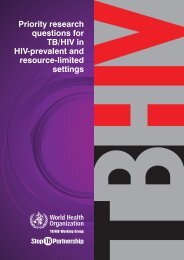
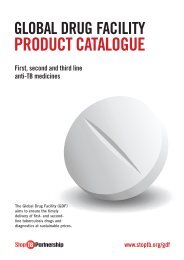
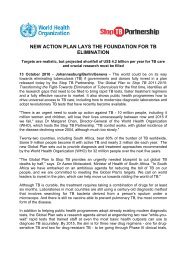
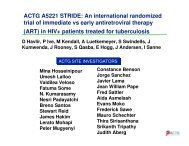
![Global Drug Facility Annual Report 2011 [.pdf] - Stop TB Partnership](https://img.yumpu.com/26788745/1/184x260/global-drug-facility-annual-report-2011-pdf-stop-tb-partnership.jpg?quality=85)

![Concept note on national stop TB partnership [.pdf]](https://img.yumpu.com/26788741/1/184x260/concept-note-on-national-stop-tb-partnership-pdf.jpg?quality=85)
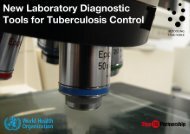

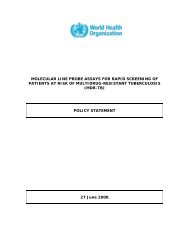
![2005 and Challenges for 2006 - 2015 [.pdf] - Stop TB Partnership](https://img.yumpu.com/26788674/1/190x245/2005-and-challenges-for-2006-2015-pdf-stop-tb-partnership.jpg?quality=85)
![Brochure (French) [.pdf] - Stop TB Partnership](https://img.yumpu.com/17234792/1/190x91/brochure-french-pdf-stop-tb-partnership.jpg?quality=85)

